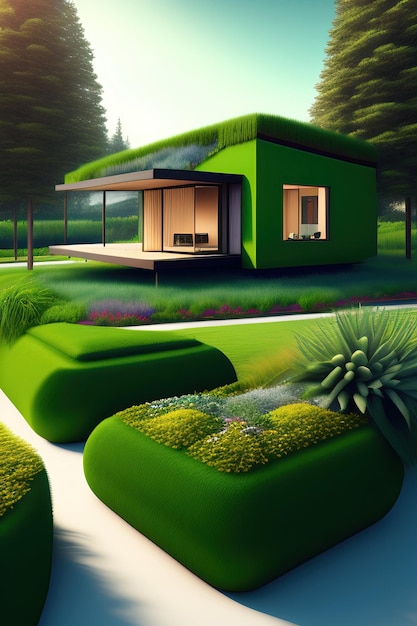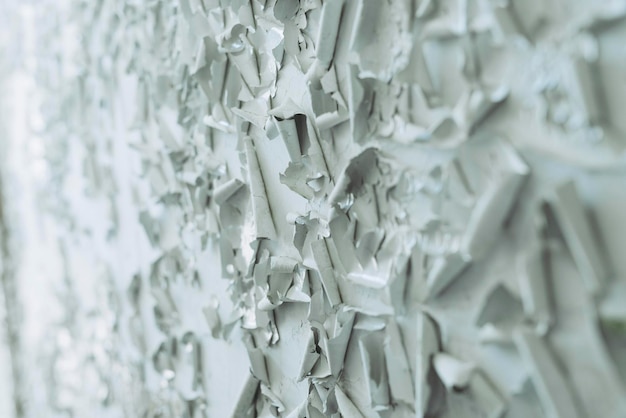3D Printing: Revolutionizing Home Construction Within 5 Years

3D printing is poised to revolutionize home construction within the next 5 years, offering faster, more affordable, and sustainable building solutions compared to traditional methods.
Imagine a world where homes are built faster, cheaper, and with less environmental impact. This vision is rapidly becoming a reality thanks to how 3D printing could revolutionize home construction in the next 5 years. Let’s delve into this exciting future and explore the possibilities.
3D Printing: A New Era for Home Construction
The construction industry is often slow to adopt new technologies. However, 3D printing is rapidly changing this, offering a revolutionary approach to building homes. It’s no longer a futuristic fantasy; it’s a present-day reality with the potential to transform how we live.
This technology promises to drastically reduce construction time, lower costs, and minimize waste, making homeownership more accessible and sustainable. But how, exactly, will this happen?
Speed and Efficiency in Construction
One of the most significant advantages of 3D printing in home construction is the speed and efficiency it offers. Traditional building methods are often time-consuming, involving numerous subcontractors and complex processes.
3D printing streamlines this process, using automated systems to construct homes much faster than conventional methods.
- Reduced Construction Time: 3D printing can significantly cut down the time it takes to build a house, sometimes reducing it by weeks or even months.
- Lower Labor Costs: Automation reduces the need for large construction crews, leading to substantial savings in labor costs.
- Precise Execution: 3D printing ensures accuracy and precision, minimizing errors and rework.
- Faster Project Completion: With quicker construction times, projects can be completed faster, allowing homeowners to move in sooner.
In conclusion, 3D printing is set to redefine the pace and efficiency of home construction, offering faster, cheaper, and more precise building solutions.

Cost-Effective Housing Solutions
Affordable housing is a growing concern in many parts of the world. 3D printing offers a viable solution to this problem by significantly reducing the cost of building homes. This cost-effectiveness stems from several factors.
From material usage to labor expenses, 3D printing provides a way to make homeownership more accessible.
Material Efficiency
Traditional construction often results in a significant amount of waste due to cutting, shaping, and fitting materials. 3D printing, on the other hand, uses materials more efficiently.
This reduces waste and lowers the overall cost of the project.
- Reduced Material Waste: 3D printing uses only the necessary amount of material, minimizing waste.
- Lower Material Costs: Efficient material usage translates to lower overall material expenses.
- Sustainable Practices: By reducing waste, 3D printing promotes more sustainable building practices.
- Customizable Designs: 3D printing allows for highly customizable designs without increasing material costs.
In summary, 3D printing provides a cost-effective solution for home construction through reduced material waste, lower labor costs, and streamlined processes, making homeownership more accessible for many.
Sustainable Building Practices
Sustainability is a key consideration in modern construction. 3D printing aligns well with sustainable building practices by reducing waste, using eco-friendly materials, and minimizing environmental impact. This makes it an attractive option for environmentally conscious homeowners.
The increasing focus on green building methods could drive greater adoption of 3D printing in the coming years.
Eco-Friendly Materials
Many 3D printing projects utilize sustainable and recycled materials. These materials not only reduce the environmental footprint of the construction process but also offer comparable or superior structural integrity.
This makes 3D-printed homes more environmentally friendly than traditional ones.
- Use of Recycled Materials: 3D printing can use recycled plastics, concrete, and other materials, reducing reliance on virgin resources.
- Lower Carbon Footprint: By using sustainable materials and reducing waste, 3D printing lowers the carbon footprint of construction.
- Energy Efficiency: 3D-printed homes can be designed for optimal energy efficiency, reducing long-term energy consumption.
- Reduced Construction Waste: Minimizing waste contributes to more sustainable and environmentally responsible building practices.
In brief, 3D printing can revolutionize home construction by promoting sustainable building practices, using eco-friendly materials, and reducing the overall environmental impact of the construction process.

Customization and Design Flexibility
One of the most appealing aspects of 3D printing is the ability to create highly customized home designs. Traditional construction often involves limitations in design and requires significant alterations for unique requests. 3D printing removes many of these barriers, allowing for greater design flexibility.
This versatility makes it possible to create homes that perfectly fit the needs and preferences of individual homeowners.
Innovative Architectural Designs
3D printing enables architects and designers to explore innovative and unique architectural designs. Complex curves and unconventional shapes that would be difficult or impossible to achieve with traditional methods can be easily realized with 3D printing.
This opens up a whole new world of possibilities for home design.
- Unique Architectural Forms: 3D printing allows for the creation of complex and visually stunning architectural designs.
- Personalized Home Layouts: Homeowners can customize the layout of their homes to suit their specific needs and preferences.
- Integration of Smart Home Technology: Wiring and technology can be seamlessly integrated into the printing process.
- Adaptable Housing Solutions: 3D printing enables the creation of homes that can be easily adapted and expanded over time.
In conclusion, 3D printing greatly enhances customization and design flexibility in home construction, allowing for innovative architectural forms, personalized layouts, and adaptable housing solutions.
Addressing Housing Shortages
Housing shortages are a pressing issue in many regions, particularly in urban areas and disaster-stricken zones. 3D printing offers a rapid and efficient solution for addressing these shortages by quickly constructing affordable and livable homes.
The ability to deploy 3D printing technology in areas with urgent housing needs can significantly improve living conditions and provide shelter to vulnerable populations.
Rapid Deployment in Disaster Areas
In the aftermath of natural disasters, 3D printing can be used to quickly construct emergency shelters and temporary housing. This rapid deployment can provide immediate relief to those who have lost their homes.
It offers a practical solution for rebuilding communities and providing safe shelter.
- Quick Construction of Shelters: 3D printing facilitates the rapid construction of shelters in disaster-stricken areas.
- Affordable Housing Options: The cost-effectiveness of 3D printing makes it a viable solution for creating affordable housing.
- Improved Living Conditions: By providing safe, durable, and comfortable homes, 3D printing improves living conditions.
- Community Reconstruction: 3D printing aids in the reconstruction of communities, helping people rebuild their lives.
In summary, with its rapid deployment capabilities and cost-effectiveness, 3D printing can be a powerful tool for addressing housing shortages, especially in disaster-stricken areas, providing shelter and aiding community reconstruction.
Challenges and Future Outlook
While 3D printing holds immense promise for revolutionizing home construction, it also faces certain challenges. These challenges range from regulatory hurdles to technological limitations and public acceptance. Overcoming these obstacles is crucial for the widespread adoption of 3D printing in the housing industry.
Despite these challenges, the future outlook for 3D printing in home construction is bright, with ongoing advancements and increasing acceptance.
Regulatory Considerations
One of the primary challenges facing the 3D printing industry is the need for updated building codes and regulations. Existing codes often do not account for the unique aspects of 3D-printed structures, creating uncertainty and hindering adoption.
Adapting and updating regulations is essential for ensuring the safety and viability of 3D-printed homes.
- Updating Building Codes: Building codes need to be updated to accommodate the unique aspects of 3D-printed structures.
- Ensuring Structural Integrity: Regulations must ensure the structural integrity and safety of 3D-printed homes.
- Addressing Material Standards: Standards for the materials used in 3D printing need to be established and enforced.
- Promoting Public Acceptance: Clear and consistent regulations can help promote public confidence and acceptance of 3D-printed homes.
In short, addressing regulatory considerations through updated building codes, material standards, and safety regulations is essential for the future growth and acceptance of 3D printing in home construction.
| Key Point | Brief Description |
|---|---|
| ⏱️ Speed & Efficiency | Reduces construction time and labor costs through automated systems. |
| 💰 Cost-Effective | Lowers housing costs by minimizing material waste and labor expenses. |
| 🌱 Sustainable | Uses eco-friendly materials and reduces environmental impact. |
| 📐 Customization | Allows for innovative designs and personalized home layouts. |
Frequently Asked Questions
▼
A 3D-printed house can be built much faster than a traditional house, often within a few days or weeks, depending on the size and complexity of the design. This speed is due to the automated nature of the 3D printing process.
▼
Yes, 3D-printed homes are designed to meet or exceed building codes and safety standards. The materials used are tested for structural integrity and durability, ensuring that the homes are safe and habitable for residents.
▼
3D-printed homes can be constructed using a variety of materials, including concrete, recycled plastics, and sustainable composites. The choice of material depends on the specific project requirements, environmental considerations, and cost factors.
▼
The cost of building a 3D-printed house is generally lower than traditional construction due to reduced labor and material waste. The exact cost varies depending on the size, design, and location of the home, but it is often a more affordable option.
▼
Yes, 3D-printed homes offer a high degree of customization. Architects and designers can create unique and personalized home layouts that cater to the homeowner’s specific needs and preferences, allowing for innovative and adaptable designs.
Conclusion
In conclusion, how 3D printing could revolutionize home construction in the next 5 years is a very real possibility, promising faster, more affordable, and sustainable housing solutions. While challenges remain, ongoing advancements and increasing acceptance indicate a bright future for 3D printing in the housing industry, paving the way for innovative and accessible homes for all.





